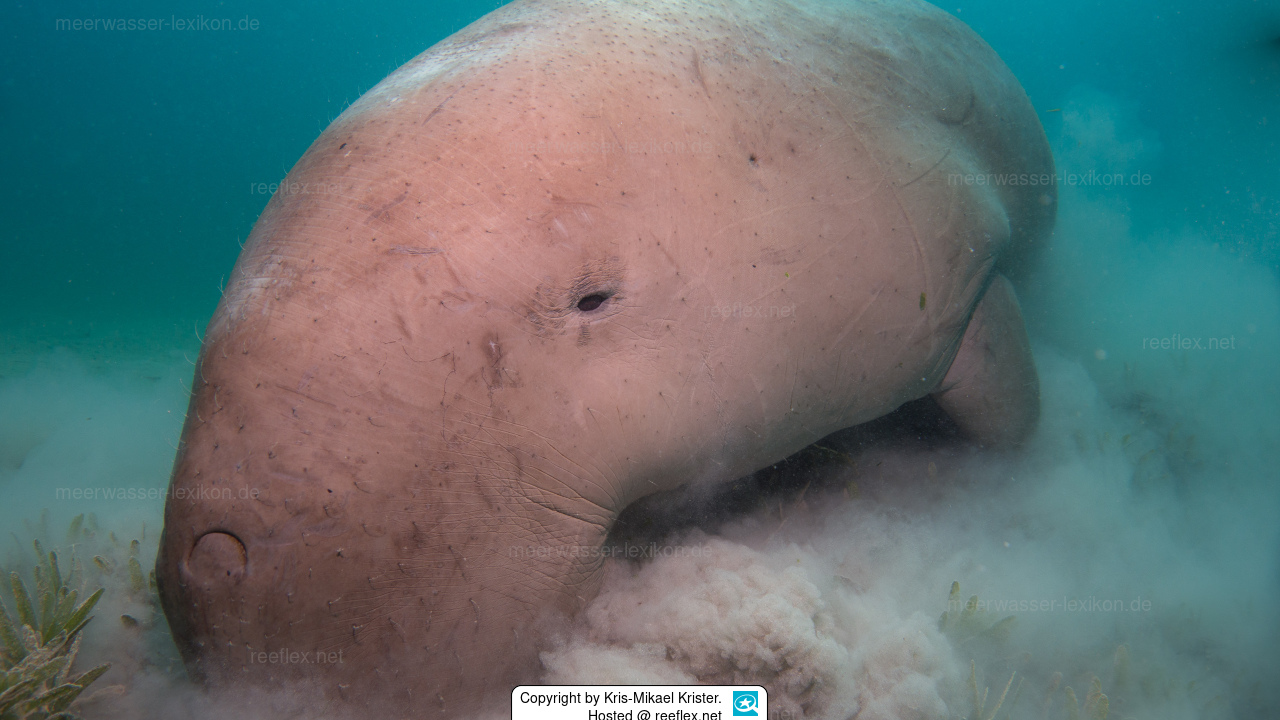Info
The dugong dugon, the fork-tailed manatee, has been the subject of myths and stories for centuries, in which the marine mammals are said to have appeared to many sailors as mermaids or sea maidens.
In fact, fork-tailed manatees are calm, leisurely and harmless herbivores that are now on the verge of extinction on the east coast of Africa.
At the last count, just 250 animals could be counted.
Fishing nets in particular quickly and far too often become deadly traps for them, preventing the manatees from surfacing and breathing, so that the animals are cruelly drowned.
Dugong dugons are grayish brown with small ears and eyes, they have a prominent snout with 2 nostrils and a broad, rounded upper lip.
Superficially, a fork-tailed dugon resembles a round-headed dolphin.
The mouth is hidden under the head, and the upper lip is broad and bristled.
The manatee has no dorsal fin, but has rounded, paddle-shaped pectoral fins and flattened caudal fins.
If lucky, manatees can sometimes be seen feeding in herds, once as large as 100 animals, now more like 6.
Under optimal conditions, the animals are very long-lived (up to 70 years), not reproducing until they are at least 6 years old.
Males fight each other to mate with females, and reproduction occurs only every few years (can last up to 7 years).
Gestation period is about 13 to 14 months, and a single calf is born.
Marine habitat, associated with seagrass beds, the dugong's diet consists of various types of bottom vegetation, primarily seagrass.
Feeding grounds of dugongs, exposed by tides, show feeding traces in seagrass beds.
Note: In the literature often appears a reference about a specimen that should have had a length of 4.06 meters and a weight of 1016 Kg, meanwhile these data are considered as errors.
Synonyms:
Halicore dugong (Gmelin) Illiger, 1811
Halicore halicore
Trichechus dugon Müller, 1776
Trichechus dugong Gmelin, 1788
In fact, fork-tailed manatees are calm, leisurely and harmless herbivores that are now on the verge of extinction on the east coast of Africa.
At the last count, just 250 animals could be counted.
Fishing nets in particular quickly and far too often become deadly traps for them, preventing the manatees from surfacing and breathing, so that the animals are cruelly drowned.
Dugong dugons are grayish brown with small ears and eyes, they have a prominent snout with 2 nostrils and a broad, rounded upper lip.
Superficially, a fork-tailed dugon resembles a round-headed dolphin.
The mouth is hidden under the head, and the upper lip is broad and bristled.
The manatee has no dorsal fin, but has rounded, paddle-shaped pectoral fins and flattened caudal fins.
If lucky, manatees can sometimes be seen feeding in herds, once as large as 100 animals, now more like 6.
Under optimal conditions, the animals are very long-lived (up to 70 years), not reproducing until they are at least 6 years old.
Males fight each other to mate with females, and reproduction occurs only every few years (can last up to 7 years).
Gestation period is about 13 to 14 months, and a single calf is born.
Marine habitat, associated with seagrass beds, the dugong's diet consists of various types of bottom vegetation, primarily seagrass.
Feeding grounds of dugongs, exposed by tides, show feeding traces in seagrass beds.
Note: In the literature often appears a reference about a specimen that should have had a length of 4.06 meters and a weight of 1016 Kg, meanwhile these data are considered as errors.
Synonyms:
Halicore dugong (Gmelin) Illiger, 1811
Halicore halicore
Trichechus dugon Müller, 1776
Trichechus dugong Gmelin, 1788







 Kris-Mikael Krister, Norwegen
Kris-Mikael Krister, Norwegen

